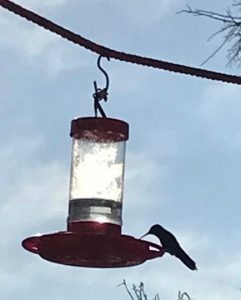Just before sunset, closing time at El Bar Colibri (the name I’ve given my hummingbird feeders), all of the hummingbirds in this vicinity swoop in for their last drink of the day.
Throughout the day other winged creatures manage to horn in — bees galore, and other, bigger, aggressive birds with long beaks – to take advantage of my sweet, free drinks. But just before the sun sets, uncountable hummingbirds (colibris) claim these feeders for themselves and drink their fill.

Watching these colibris each evening, I’m reminded of the sundowners I and my friends shared in southern Africa fifty years ago, when we were in our twenties. We’d gather at a friend’s place for a pre-dinner drink, sit outside on the patio, and admire in awe the African sun going down like clockwork at six. As I’ve written elsewhere, Africa’s sun:
“… sets in a dramatic show, like that of an old magician who knows his act cold: plucking colors from the day in a dazzling display – bougainvillea red, jacaranda mauve, flame-lily orange — and pulling them in vivid ribbons through the sky into the inverted hat of the horizon. Then – POOF! – lights out – the show is over, and a huge, royal-blue, star-studded curtain covers the stage” (Somewhere Child, p. 234).
Now it’s the colibris’ turn, I think, as I study them, adoringly, from my patio here in Mexico. They are enjoying their sundowners now.
I’m not an ornithologist or even a bird-watcher, per se. I don’t go out into the bush looking for birds, with binoculars hung from my neck. Instead, I prefer to wait for birds to come to my place, like surprise guests. Deep down, I think I envy them – their seeming weightlessness, their freedom, their skill, their grace. I study them to learn from them because they are the opposite of me.
Another memory:
In the Peace Corps in Gabon, when I was in my early fifties, I would sit by my window at dawn, drinking hot, sweet, milky tea, and watch the yellow weaverbirds already hard at work outside in the nearest palm tree.
For the first time in my life, it seemed, I had time to sit back and observe birds. In my twenty years living and working in New York City I was always in a rush, always stressed. The only birds I ever noticed there were the citified, opportunistic pigeons, who never sang. Or if they did, they never sang to me.
In Gabon then I studied one weaver as she used her beak to tear thin palm fronds into thinner strips and then weave them, patiently, methodically, painstakingly into her elongated, capsule-like nest. How did she know to tie her nest so firmly to the tree and make the nest’s opening at the bottom? I wondered. How could she be so ingenious and indefatigable? She didn’t quit. And she seemed so happy in her work – singing full-heartedly the whole time, as though it were pure joy.
Dozens of nests just like hers hung from that palm tree like Christmas ornaments. These nests, with their openings underneath, I saw, miraculously stayed put – despite the lashing rains and gale-like winds of the merciless rainy seasons. These nests were built to last. What little architectural wonders, I thought. And what skill and tenacity it took to weave them!
The Africans there had an idiomatic expression that I took as my own at the time because it taught me patience: “Petit a petit l’oiseau fait son nid” – little by little the bird makes her nest. Yes, I told myself: Take a lesson from those birds.
And then of course there was the rooster in Africa that I adopted as my pet, who taught me the power of proximity to alter one’s point of view.
He – I named him Dîner, the French word for “dinner” and “to dine” – was the first living, crowing rooster I’d ever gotten that close to in the feathered flesh. Since I hadn’t grown up on a farm, poultry for me had always been something encountered only in a cold, plucked, gutted, raw, lifeless, ready-to-roast form in a grocer’s or butcher’s refrigerated meat case.
Although roast chicken with rice has always been one of my favorite meals, and good food was hard to come by deep in Gabon’s rainforest, I couldn’t even dream of eating Dîner. He was too beautiful, too elegant, too utterly regal.
Below his bright-red crown, his body was covered by a feather cape the color of polished copper pots, and his haughty, black tail reminded me of my best black silk pants. He was dignified, too, and proud. I loved the way he strutted around my house – kingly head held high, copper chest puffed way out – like he owned the place. And what a voice! Vibrant, piercing, ear-splitting, in fact, at close range. When he hopped up on my front porch and serenaded me at dawn every day, I found the sound of his commanding cock-a-doodle-doos strangely comforting.
Yes, proximity, I learned from Dîner, like timing, can make all the difference in this world.
This week, I noticed here in San Miguel de Allende, that the snowbirds have returned. These are big, loud beings from colder climates (the U.S. mostly), who have been away too long, they say, due to COVID. Like college kids on spring break, these retirees are excited to be here, patting each other on the back for surviving, returning. I’m happy for them but a bit taken-aback. It was so quiet here without them.

I mustn’t judge. We are all guests here. And pretty soon – POOF! – it’ll be lights out for all of us. So we, like the colibris, must enjoy our beautiful sundowners while we can.
